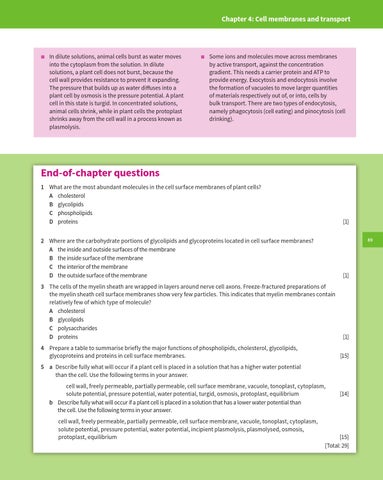Chapter 4: Cell membranes and transport
■■
In dilute solutions, animal cells burst as water moves into the cytoplasm from the solution. In dilute solutions, a plant cell does not burst, because the cell wall provides resistance to prevent it expanding. The pressure that builds up as water diffuses into a plant cell by osmosis is the pressure potential. A plant cell in this state is turgid. In concentrated solutions, animal cells shrink, while in plant cells the protoplast shrinks away from the cell wall in a process known as plasmolysis.
■■
Some ions and molecules move across membranes by active transport, against the concentration gradient. This needs a carrier protein and ATP to provide energy. Exocytosis and endocytosis involve the formation of vacuoles to move larger quantities of materials respectively out of, or into, cells by bulk transport. There are two types of endocytosis, namely phagocytosis (cell eating) and pinocytosis (cell drinking).
End-of-chapter questions 1 What are the most abundant molecules in the cell surface membranes of plant cells? A cholesterol B glycolipids C phospholipids D proteins
[1] 89
2 Where are the carbohydrate portions of glycolipids and glycoproteins located in cell surface membranes? A the inside and outside surfaces of the membrane B the inside surface of the membrane C the interior of the membrane D the outside surface of the membrane
[1]
3 The cells of the myelin sheath are wrapped in layers around nerve cell axons. Freeze-fractured preparations of the myelin sheath cell surface membranes show very few particles. This indicates that myelin membranes contain relatively few of which type of molecule? A cholesterol B glycolipids C polysaccharides D proteins
[1]
4 Prepare a table to summarise briefly the major functions of phospholipids, cholesterol, glycolipids, glycoproteins and proteins in cell surface membranes.
[15]
5 a Describe fully what will occur if a plant cell is placed in a solution that has a higher water potential than the cell. Use the following terms in your answer. cell wall, freely permeable, partially permeable, cell surface membrane, vacuole, tonoplast, cytoplasm, solute potential, pressure potential, water potential, turgid, osmosis, protoplast, equilibrium b Describe fully what will occur if a plant cell is placed in a solution that has a lower water potential than the cell. Use the following terms in your answer. cell wall, freely permeable, partially permeable, cell surface membrane, vacuole, tonoplast, cytoplasm, solute potential, pressure potential, water potential, incipient plasmolysis, plasmolysed, osmosis, protoplast, equilibrium
[14]
[15] [Total: 29]
